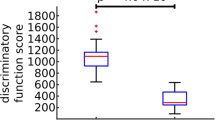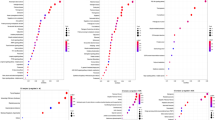Abstract
Purpose
Lynch syndrome (LS) is a common inherited predisposition to colorectal cancer (CRC). In LS patients, CRC is predominantly located in the right colon, as opposed to sporadic CRC, which usually affects the left colon or rectum. Previous studies have demonstrated a clear distinction in gene expression between sporadic CRC and normal colon at different locations in the colorectum. However, little is known about LS gene expression profiles in different areas of the colorectum. Here, we compared the protein expression profiles for normal colorectal samples among different locations as well as between adenomas and matched normal tissue in LS.
Methods
Protein from 33 tissue samples (27 normal tissues and 6 adenomas) from 9 patients with LS was extracted for reverse-phase protein array (RPPA) analysis. The antibody panel used for RPPA included 109 key proteins involved in various cancer-related pathways. Cluster 3.0 was used for unsupervised and supervised clustering analysis.
Results
IGF1R and COL6A1 were expressed significantly differently between the normal right and normal left colon (q < 0.05); FN1, COL6A1, and IGF1R were expressed significantly differently between the normal right colon and normal rectum (q < 0.05). In the adenomas and matched normal tissue, PEA-15 was the only protein with significantly different expression (q < 0.05).
Conclusion
We found differences in protein expression between normal tissues from the right colon, left colon, and rectum as well as between adenomas and matched normal tissue. However, those differences should be further confirmed in a larger sample size.


Similar content being viewed by others
References
Aarnio M, Mecklin JP, Aaltonen LA, Nystrom-Lahti M, Jarvinen HJ (1995) Life-time risk of different cancers in hereditary non-polyposis colorectal cancer (HNPCC) syndrome. Int J Cancer 64(6):430–433
Bara J, Nardelli J, Gadenne C, Prade M, Burtin P (1984) Differences in the expression of mucus-associated antigens between proximal and distal human colon adenocarcinomas. Br J Cancer 49(4):495–501
Boland CR, Thibodeau SN, Hamilton SR, Sidransky D, Eshleman JR, Burt RW, Meltzer SJ, Rodriguez-Bigas MA, Fodde R, Ranzani GN, Srivastava S (1998) A National Cancer Institute Workshop on Microsatellite Instability for cancer detection and familial predisposition: development of international criteria for the determination of microsatellite instability in colorectal cancer. Cancer Res 58(22):5248–5257
Bufill JA (1990) Colorectal cancer: evidence for distinct genetic categories based on proximal or distal tumor location. Ann Intern Med 113(10):779–788
Carethers JM (2011) One colon lumen but two organs. Gastroenterology 141(2):411–412. doi:10.1053/j.gastro.2011.06.029
Fiory F, Formisano P, Perruolo G, Beguinot F (2009) Frontiers: PED/PEA-15, a multifunctional protein controlling cell survival and glucose metabolism. Am J Physiol Endocrinol Metab 297(3):E592–E601. doi:10.1152/ajpendo.00228.2009
Formisano P, Perruolo G, Libertini S, Santopietro S, Troncone G, Raciti GA, Oriente F, Portella G, Miele C, Beguinot F (2005) Raised expression of the antiapoptotic protein ped/pea-15 increases susceptibility to chemically induced skin tumor development. Oncogene 24(47):7012–7021. doi:10.1038/sj.onc.1208871
Gervaz P, Bucher P, Morel P (2004) Two colons-two cancers: paradigm shift and clinical implications. J Surg Oncol 88(4):261–266. doi:10.1002/jso.20156
Glebov OK, Rodriguez LM, Nakahara K, Jenkins J, Cliatt J, Humbyrd CJ, DeNobile J, Soballe P, Simon R, Wright G, Lynch P, Patterson S, Lynch H, Gallinger S, Buchbinder A, Gordon G, Hawk E, Kirsch IR (2003) Distinguishing right from left colon by the pattern of gene expression. Cancer Epidemiol Biomarkers Prev 12(8):755–762
Hampel H, Frankel WL, Martin E, Arnold M, Khanduja K, Kuebler P, Clendenning M, Sotamaa K, Prior T, Westman JA, Panescu J, Fix D, Lockman J, LaJeunesse J, Comeras I, de la Chapelle A (2008) Feasibility of screening for Lynch syndrome among patients with colorectal cancer. J Clin Oncol Off J Am Soc Clin Oncol 26(35):5783–5788. doi:10.1200/JCO.2008.17.5950
Hao C, Beguinot F, Condorelli G, Trencia A, Van Meir EG, Yong VW, Parney IF, Roa WH, Petruk KC (2001) Induction and intracellular regulation of tumor necrosis factor-related apoptosis-inducing ligand (TRAIL) mediated apotosis in human malignant glioma cells. Cancer Res 61(3):1162–1170
Howlader N, Noone AM, Krapcho M, Neyman N, Aminou R, Altekruse SF, Kosary CL, Ruhl J, Tatalovich Z, Cho H, Mariotto A, Eisner MP, Lewis DR, Chen HS, Feuer EJ, Cronin KA (eds) 2012 SEER cancer statistics review, 1975–2009 (Vintage 2009 populations). Based on November 2011 SEER data submission, posted to SEER website
Hwang S, Kuo WL, Cochran JF, Guzman RC, Tsukamoto T, Bandyopadhyay G, Myambo K, Collins CC (1997) Assignment of HMAT1, the human homolog of the murine mammary transforming gene (MAT1) associated with tumorigenesis, to 1q21.1, a region frequently gained in human breast cancers. Genomics 42(3):540–542
Iacopetta B (2002) Are there two sides to colorectal cancer? Int J Cancer 101(5):403–408. doi:10.1002/ijc.10635
Iadevaia S, Lu Y, Morales FC, Mills GB, Ram PT (2010) Identification of optimal drug combinations targeting cellular networks: integrating phospho-proteomics and computational network analysis. Cancer Res 70(17):6704–6714. doi:10.1158/0008-5472.CAN-10-0460
Jensen OM (1984) Different age and sex relationship for cancer of subsites of the large bowel. Br J Cancer 50(6):825–829
Kastrinos F, Stoffel EM, Balmana J, Steyerberg EW, Mercado R, Syngal S (2008) Phenotype comparison of MLH1 and MSH2 mutation carriers in a cohort of 1,914 individuals undergoing clinical genetic testing in the United States. Can Epidemiol Biomarkers Prev 17(8):2044–2051. doi:10.1158/1055-9965.EPI-08-0301
Komuro K, Tada M, Tamoto E, Kawakami A, Matsunaga A, Teramoto K, Shindoh G, Takada M, Murakawa K, Kanai M, Kobayashi N, Fujiwara Y, Nishimura N, Hamada J, Ishizu A, Ikeda H, Kondo S, Katoh H, Moriuchi T, Yoshiki T (2005) Right- and left-sided colorectal cancers display distinct expression profiles and the anatomical stratification allows a high accuracy prediction of lymph node metastasis. J Surg Res 124(2):216–224. doi:10.1016/j.jss.2004.10.009
LaPointe LC, Dunne R, Brown GS, Worthley DL, Molloy PL, Wattchow D, Young GP (2008) Map of differential transcript expression in the normal human large intestine. Physiol Genomics 33(1):50–64. doi:10.1152/physiolgenomics.00185.2006
Ligtenberg MJ, Kuiper RP, Chan TL, Goossens M, Hebeda KM, Voorendt M, Lee TY, Bodmer D, Hoenselaar E, Hendriks-Cornelissen SJ, Tsui WY, Kong CK, Brunner HG, van Kessel AG, Yuen ST, van Krieken JH, Leung SY, Hoogerbrugge N (2009) Heritable somatic methylation and inactivation of MSH2 in families with Lynch syndrome due to deletion of the 3′ exons of TACSTD1. Nat Genet 41(1):112–117. doi:10.1038/ng.283
Lindor NM, McMaster ML, Lindor CJ, Greene MH, National Cancer Institute DoCPCO, Prevention Trials Research G (2008) Concise handbook of familial cancer susceptibility syndromes—second edition. J Natl Cancer Inst Monogr 38:1–93. doi:10.1093/jncimonographs/lgn001
Lynch HT, Lanspa S, Smyrk T, Boman B, Watson P, Lynch J (1991) Hereditary nonpolyposis colorectal cancer (Lynch syndromes I and II). Genetics, pathology, natural history, and cancer control, part I. Cancer Genet Cytogenet 53(2):143–160
Marra G, Boland CR (1995) Hereditary nonpolyposis colorectal cancer: the syndrome, the genes, and historical perspectives. J Natl Cancer Inst 87(15):1114–1125
Mecklin JP, Jarvinen HJ (1991) Tumor spectrum in cancer family syndrome (hereditary nonpolyposis colorectal cancer). Cancer 68(5):1109–1112
Minoo P, Zlobec I, Peterson M, Terracciano L, Lugli A (2010) Characterization of rectal, proximal and distal colon cancers based on clinicopathological, molecular and protein profiles. Int J Oncol 37(3):707–718
Niessen RC, Hofstra RM, Westers H, Ligtenberg MJ, Kooi K, Jager PO, de Groote ML, Dijkhuizen T, Olderode-Berends MJ, Hollema H, Kleibeuker JH, Sijmons RH (2009) Germline hypermethylation of MLH1 and EPCAM deletions are a frequent cause of Lynch syndrome. Genes Chromosomes Cancer 48(8):737–744. doi:10.1002/gcc.20678
Pande M, Wei C, Chen J, Amos CI, Lynch PM, Lu KH, Lucio LA, Boyd-Rogers SG, Bannon SA, Mork ME, Frazier ML (2012) Cancer spectrum in DNA mismatch repair gene mutation carriers: results from a hospital based Lynch syndrome registry. Fam Cancer. doi:10.1007/s10689-012-9534-6
Ramirez–Ramirez MA, Sobrino-Cossio S, de la Mora-Levy JG, Hernandez-Guerrero A, de Macedo-Reyes JV, Maldonado-Martinez HA, Alonso-Larraga JO, Ramirez-Solis ME (2012) Loss of expression of DNA mismatch repair proteins in aberrant crypt foci identified in vivo by magnifying colonoscopy in subjects with hereditary nonpolyposic and sporadic colon rectal cancer. J Gastrointest cancer 43(2):209–214. doi:10.1007/s12029-011-9303-z
Rijcken FE, Hollema H, Kleibeuker JH (2002) Proximal adenomas in hereditary non-polyposis colorectal cancer are prone to rapid malignant transformation. Gut 50(3):382–386
Sanz-Pamplona R, Cordero D, Berenguer A, Lejbkowicz F, Rennert H, Salazar R, Biondo S, Sanjuan X, Pujana MA, Rozek L, Giordano TJ, Ben-Izhak O, Cohen HI, Trougouboff P, Bejhar J, Sova Y, Rennert G, Gruber SB, Moreno V (2011) Gene expression differences between colon and rectum tumors. Clin Cancer Res 17(23):7303–7312. doi:10.1158/1078-0432.CCR-11-1570
Stassi G, Garofalo M, Zerilli M, Ricci-Vitiani L, Zanca C, Todaro M, Aragona F, Limite G, Petrella G, Condorelli G (2005) PED mediates AKT-dependent chemoresistance in human breast cancer cells. Cancer Res 65(15):6668–6675. doi:10.1158/0008-5472.CAN-04-4009
Sun DG, Wu YF, Gao ZM, Liang R, Wang LM (2010) Expression and clinical significance of anti-apoptotic factors PED/PEA-15 and XIAP in hepatocellular carcinoma. Zhonghua yi xue za zhi 90(24):1660–1664
Tsukamoto T, Yoo J, Hwang SI, Guzman RC, Hirokawa Y, Chou YC, Olatunde S, Huang T, Bera TK, Yang J, Nandi S (2000) Expression of MAT1/PEA-15 mRNA isoforms during physiological and neoplastic changes in the mouse mammary gland. Cancer Lett 149(1–2):105–113
Vasen HF (2005) Clinical description of the Lynch syndrome [hereditary nonpolyposis colorectal cancer (HNPCC)]. Fam Cancer 4(3):219–225. doi:10.1007/s10689-004-3906-5
Worthley DL, Whitehall VL, Buttenshaw RL, Irahara N, Greco SA, Ramsnes I, Mallitt KA, Le Leu RK, Winter J, Hu Y, Ogino S, Young GP, Leggett BA (2010) DNA methylation within the normal colorectal mucosa is associated with pathway-specific predisposition to cancer. Oncogene 29(11):1653–1662. doi:10.1038/onc.2009.449
Xiao C, Yang BF, Asadi N, Beguinot F, Hao C (2002) Tumor necrosis factor-related apoptosis-inducing ligand-induced death-inducing signaling complex and its modulation by c-FLIP and PED/PEA-15 in glioma cells. J Biol Chem 277(28):25020–25025. doi:10.1074/jbc.M202946200
Yamauchi M, Lochhead P, Morikawa T, Huttenhower C, Chan AT, Giovannucci E, Fuchs C, Ogino S (2012a) Colorectal cancer: a tale of two sides or a continuum? Gut 61(6):794–797. doi:10.1136/gutjnl-2012-302014
Yamauchi M, Morikawa T, Kuchiba A, Imamura Y, Qian ZR, Nishihara R, Liao X, Waldron L, Hoshida Y, Huttenhower C, Chan AT, Giovannucci E, Fuchs C, Ogino S (2012b) Assessment of colorectal cancer molecular features along bowel subsites challenges the conception of distinct dichotomy of proximal versus distal colorectum. Gut 61(6):847–854. doi:10.1136/gutjnl-2011-300865
Acknowledgments
This research was supported in part by the National Institutes of Health through MD Anderson’s Cancer Center Support Grant (CA016672) and research grant 5R01CA070759-11. We thank Haidee Chancoco for technical assistance with sample preparation and Ms. Dawn Chalaire for her editorial comments.
Conflict of interest
None.
Author information
Authors and Affiliations
Corresponding author
Additional information
Chongjuan Wei and Jinyun Chen contributed equally to this work.
Rights and permissions
About this article
Cite this article
Wei, C., Chen, J., Pande, M. et al. A pilot study comparing protein expression in different segments of the normal colon and rectum and in normal colon versus adenoma in patients with Lynch syndrome. J Cancer Res Clin Oncol 139, 1241–1250 (2013). https://doi.org/10.1007/s00432-013-1437-x
Received:
Accepted:
Published:
Issue Date:
DOI: https://doi.org/10.1007/s00432-013-1437-x




